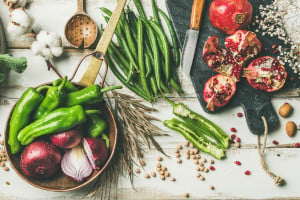You’ve probably been making this trio of vegetables your entire life (or, at least as long as you’ve been cooking). It forms the base of many a soup and stew and adds flavor, depth, and texture to many favorite Western dishes. It’s a simple blend of diced celery, onions, and carrots.

However, did you know that this vegetable trio has a name? Mirepoix is a complicated-sounding French term that refers to this oh-so-simple combination of flavors, textures, and colors. Here’s what you need to know.
What is Mirepoix?
As simple as it is, mirepoix does come with some rules. To truly be classic, French mirepoix, the combo must be made in a ratio of equal parts carrots and celery to two parts onion (you can remember the ratio as 2:1:1 for onions, carrots, and celery, respectively). Additionally, a classic mirepoix base is cooked slowly (no browning those onions!) to release the flavors in the fat of your choice. Once the vegetables are cooked, you can move on to use them as a base for whatever final dish you have in mind, whether that be soup, sauce, or stuffing.
So how do you pronounce it? It’s easier than you likely assume. This French term is pronounced “meer-pwah.”
Mirepoix vs. The Holy Trinity (And Other Similar Combinations)
You might be thinking, “Hey! I use a mixture of onions, celery, and carrots in my cooking, but I’ve always called it ‘the holy trinity.’ What gives?”
As is the case with all great foods that are simple in nature but still impressive flavor-wise, many cultures and countries have developed their own combinations of vegetables and like ingredients to use as bases in soups and sauces, similar to mirepoix. These cultural and geography-specific combinations and their slight differences often come about due to that culture’s culinary preferences or, sometimes, simply what foods are most readily available.
The holy trinity, for example, is found in a lot of Southern cooking, and it includes onions and celery, but bell peppers instead of carrots.
Soffrito is the Italian version of mirepoix, with the exact same ingredients: onions, celery, and carrots. However, the Italians sometimes add a little extra flavor to their mixture, with garlic. Don’t mistake the Italian “soffrito” with “sofrito,” though; drop the extra “f” and you have the Spanish version, with onion, tomatoes, bell peppers, and garlic.
Recipe Ideas
So now that you know what a classic French mirepoix is and how it differs from other, similar vegetable bases, how can you use it?
To start, with any recipe that uses mirepoix, be sure that you have the ratios correct (remember: equal parts carrots and celery but double the onion). Thoroughly clean and peel your vegetables. Then, dice them finely and equally and cook them low and slow.
From there, you could use the mixture as a base for a warming and winter-ready bowl of lentil soup or a perfect-for-cold-season batch of chicken soup. Mirepoix finds an easy home in just about any favorite soup or stew recipe. It also makes a great, veggie-filled base for chunky sauces, like a Bolognese sauce to pour over your favorite pasta.
Classic Mirepoix
Equipment
- 1 large skillet
Ingredients
- 2 cups onions chopped
- 1 cup carrots chopped
- 1 cup celery chopped
- 1 tbsp butter or olive oil, or a mix of both
Instructions
- Clean and peel the onions and carrots. Wash the celery. Finely chop the onions, carrots, and celery into uniform pieces. The size of the pieces can vary depending on the intended use, but they are typically kept small.
- In a large skillet, heat some butter (or olive oil) over medium heat. Add the chopped vegetables to the pan.
- Cook the vegetables, stirring occasionally, until they are soft but not browned. This usually takes about 10 minutes. The goal is to sweat the vegetables so they release their flavors without caramelizing.
- Use immediately as a base for soups, stews, sauces, or other dishes. Alternatively, it can be cooled and stored in the refrigerator for a few days or frozen for longer storage.







